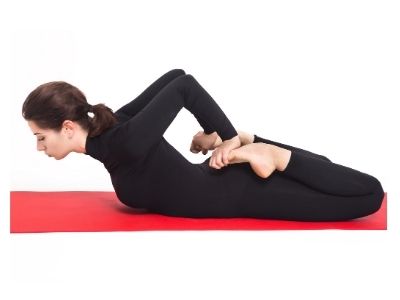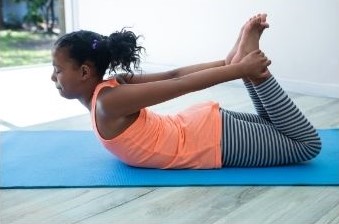Bhekasana – Frog Pose, How To Do, Benefits, Effect On Dosha
By Dr Raghuram Y.S. MD (Ay) & Dr Manasa, B.A.M.S
In Bhekasana the practitioner assumes the shape of a frog and hence the name. It is a reclining pose. It is not described in medieval Hatha Yoga treatises. It is found to be mentioned in Light on Yoga (B.K.S. Iyengar) and Ashtanga Vinyasa Yoga (Pattabhi Jois).
Bheka = Frog
Asana = Pose, Posture
This pose is done from a prone position. From this position the knees are bent, the arms reach the back and catch the feet and press them down. The arms are reversed, the elbows point upwards and fingertips downwards. The head and chest are lifted and the performer looks upwards. It opens up the quad and hip flexors and also opens up the chest and improves the posture.
Read – Hatha Yoga and Shat Karmas: Benefits, Precautions

Preparation for Bhekasana
- Perform frog pose on empty stomach. Do it early in the morning when your stomach is empty. Alternatively you may perform the pose in the evening. You should consume food 4-6 hours before performing the asana.
- Keep your bladder and bowel empty before starting the pose.
Table of Contents
Method of doing Bhekasana
Lie flat on your belly. Have your face and chin down to the floor.
Press your forearms into the floor such that your elbows are directly underneath your shoulders and your forearms are parallel to each other. (Alternatively you can start doing this pose from Salambha Bhujangasana i.e. Sphinx Pose. In this pose you have already kept your forearms in the mentioned position and have raised your head and chest with the forearm support as if you are pulling your chest forwards through the arms.)
Read – Bhujangasana Cobra Pose, How to do, Benefits, Variants, Side Effects
a. Entering Bhekasana from Ardha Bhekasana i.e. half frog pose
- Inhale and gradually lift your head and torso off the floor.
- Exhale and bend the right knee and pull the right heel towards the right butt.
- Using your left forearm to support yourself, reach your right foot with your right hand. Grab the inside of your right foot with your right hand and pull the foot towards the right butt or to the outer border of right butt. Ground down through the right hip. Your right elbow is pointing up towards the ceiling and the fingers will turn towards the front of the mat. Now you are in ardha bhekasana i.e. half frog pose.
- Keep your rib cage engaged. Pull the navel in and up.
- Hold in this pose for 3 long breaths or for 30 seconds to 2 minutes.
- Focus on your muladhara chakra i.e. root chakra.
- Gradually release from the pose and come back to the Sphinx pose.
- Repeat the same procedure on the left side grounding on the left hip and keeping the right forearm and right side of the body neutral.
- Doing half frog poses on both sides will help in opening up your hips so that you could easily do the full frog pose i.e. Bhekasana. Half Frog pose is preparatory pose for frog pose.
Doing the Bhekasana – Now to do the Bhekasana, once again come back to the sphinx pose. From here bend both knees simultaneously. Hold both feet with your hands simultaneously and press them towards the outside of the butts, towards the ground.
Read – Health Benefits Of Yoga: Mind And Body
b. Performing Bhekasana i.e. frog pose or Frog Pose II directly
You can directly perform Bhekasana once you have mastered doing half frog pose and once your hips are opened up precisely to do the pose.
- Start with sphinx pose, chest to the earth.
- Bend both your knees.
- Hold both feet with your hands simultaneously such that your hands hold the inner feet and gradually move to the top of your feet.
- Gradually squeeze and press your feet with hands towards butts and then to the outside of butts, towards the ground. Your elbows are pointed upwards towards the ceiling.
- Square your shoulders making sure they are down and away from the ears. Keep the chest lifted.
- Ground down through your hips while you lengthen your spine and broaden your chest.
- Take a few breathes here.
(Here you can try to lift your chest unsupported. Alternatively keep your chest on the floor and focus on pushing the feet towards the outside of your butts.)
Alternative method
Sleep in prone position. Keep your arms beside your body, palms facing down. Breathe gently. Bend both your knees. Reach your feet with your hands and hold their inner part. Hold on to the upper surface of your feet gradually and squeeze your feet towards your butt and towards the outer side of the butts and ground. As you press your feet gradually lift your head, shoulders and chest upwards. If possible look up towards ceiling or sky.
Release from the asana
- Exhale.
- Slowly release your feet from the clasp.
- Extend your lower limbs.
- Bring back your upper limbs to the sides of your body.
- Put your head and chin down.
- Relax for a while and breathe easily.
Related Video
Watch this video to follow the method of doing Bhekasana
https://www.youtube.com/watch?v=Z64GBfDWtgI
Health Benefits of Bhekasana
- Opens up the hip joints
- Provides deep stretch to the legs and muscles therein
- Strengthens and stretches the lower back, stretches deep hip flexors
- Strengthens the back muscles, provides deep stretch and flexibility to the lower and middle back
- Benefits the muscles of lower back, biceps, triceps, core (abs), feet, ankles, knees and quadriceps
- Stretches ad strengthens quadriceps, upper thighs and opens up these muscles, makes the legs stronger and hence useful exercise for athletes
- Improves the muscle strength of arms, shoulders and chest
- Stretches front of the body
- Stretches and Strengthens ankles, knee joints, groins, abdomen and throat
- Improves posture
- Improves flexibility of spine, legs, chest, shoulders, neck and entire body
- Calms the body and mind
- Provides massage to the lower abdomen and muscles therein, hence improves digestive system functions
- Opens up the chest in a great way and hence improves breathing
- Creates an awareness of your breath and body
- Activates pancreas to secrete proper amounts of insulin,
- Activates the reproductive system and their hormones
- Improves functioning of adrenal glands
- Relieves menstrual cramps
- Cures flat feet
- Strengthens the sprained ankles
Preparatory Poses
- Supta Virasana – Reclining Hero Pose
- Ushtrasana – Camel Pose
- Dhanurasana – Bow pose
- Eka Pada Bhekasana – One Legged Frog Pose
Read – Chakrasana (Urdhwa Dhanurasana) Wheel Pose, Method, Benefits, Side Effects
Sequence to prepare for Bhekasana
- Parvatasana – mountain pose
- Parvatasana Gomukhasana – mountain pose with cow face arms
- Anjaneyasana – crescent moon pose with clasped hands
- Eka Pada Bhekasana – One Legged frog pose
- Anjaneyasana variation – crescent moon pose with thigh stretch
- Shalabhasana – Locust Pose
- Shalabhasana II – Locust Pose II
- Dhanurasana – bow pose
- Ardha Bhekasana – Half frog pose
- Bhekasana – frog pose (Read more)
Follow-up Poses
- Adho Mukha Svanasana – downward facing dog pose
- Suptha Padangushtasana – Reclining Big Toe Pose
- Uttanasana – Standing Forward Bend Pose
- Sarvangasana – Shoulder Stand
- Viparita Karani – Legs up the wall pose
- Shavasana – Corpse Pose
Modifications
- You can place a bolster under your lower ribs and lift in your upper torso. This will provide added support.
- Press your free forearm on the floor in front of the bolster.
- You can also grab your feet with strap.
- Half Frog – as already said is a modification for frog pose.
What time should be spent in the pose while doing Bhekasana?
Bhekasana should be done for 3 long breaths or for a time period of 30 seconds to 2 minutes or depending on your capacity to hold on to the pose. Initially it shall be done for a short duration and gradually the time period of performance shall be extended after gaining expertise on the asana.

Impact on Chakras
Bhekasana is one of the best poses to activate and balance Vishuddha Chakra – throat chakra, Anahata Chakra – heart chakra, Swadisthana Chakra – sacral chakra and Muladhara Chakra – root chakra.
Contraindications
Patients suffering from below mentioned conditions should avoid doing Bhekasana –
- High blood pressure
- Low blood pressure
- Rotator cuff injuries
- Insomnia
- Migraine
- Injuries to lower back and knee
- Stomach and intestine related ailments
Caution
Pregnant women should not perform this pose.
Be cautious not to push ankles hard towards the floor. This could injure tissues around ankle.
Don’t impart too much pressure on hips and shoulders.
Impact of Bhekasana on Doshas and Tissues
Impact on Doshas – Bhekasana is an important pose which helps in balancing all three doshas. But its balancing effect on Vata and its subtypes is clearly evident from its benefits.
Frog pose has immense balancing effect on udana and apana vata. The fact that it opens up the chest and helps in easy breathing, activates reproductive system and hormones and relieves menstrual cramps in women further substantiates its role in balancing these vata subtypes. This pose also balances samana vata as it regulates digestive functions. Since it keeps the body and mind calm and also stretches and strengthens the whole body, it balances prana and samana vata. Thus we can see that Bhekasana has balancing impact on all subtypes of vata.
Impact on tissues – Since the frog pose stretches and strengthens the muscles and the entire body and improves the flexibility of the body and joints of the body, it is beneficial for improving and maintaining the muscle health and also for the channels carrying muscle tissue.
Click to Consult Dr Raghuram Y.S. MD (Ayu)








